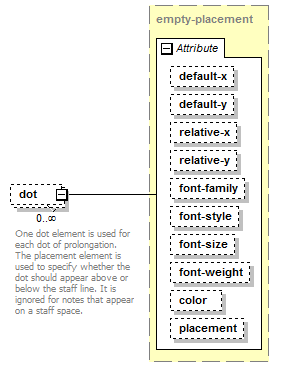dot
One dot element is used for each dot of prolongation. The placement element is used to specify whether the dot should appear above or below the staff line. It is ignored for notes that appear on a staff space. |
Element Information
Model

Attributes
| QName | Type | Fixed | Default | Use | Inheritable | Annotation |
|---|---|---|---|---|---|---|
| color | color | optional | ||||
| default-x | tenths | optional | ||||
| default-y | tenths | optional | ||||
| font-family | comma-separated-text | optional | ||||
| font-size | font-size | optional | ||||
| font-style | font-style | optional | ||||
| font-weight | font-weight | optional | ||||
| placement | above-below | optional | ||||
| relative-x | tenths | optional | ||||
| relative-y | tenths | optional |
Source
<xs:element name="dot" type="empty-placement" minOccurs="0" maxOccurs="unbounded"> <xs:annotation> <xs:documentation>One dot element is used for each dot of prolongation. The placement element is used to specify whether the dot should appear above or below the staff line. It is ignored for notes that appear on a staff space.</xs:documentation> </xs:annotation> </xs:element> |